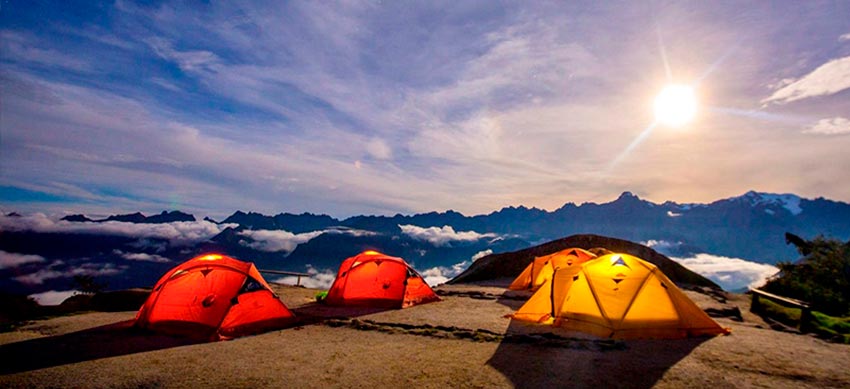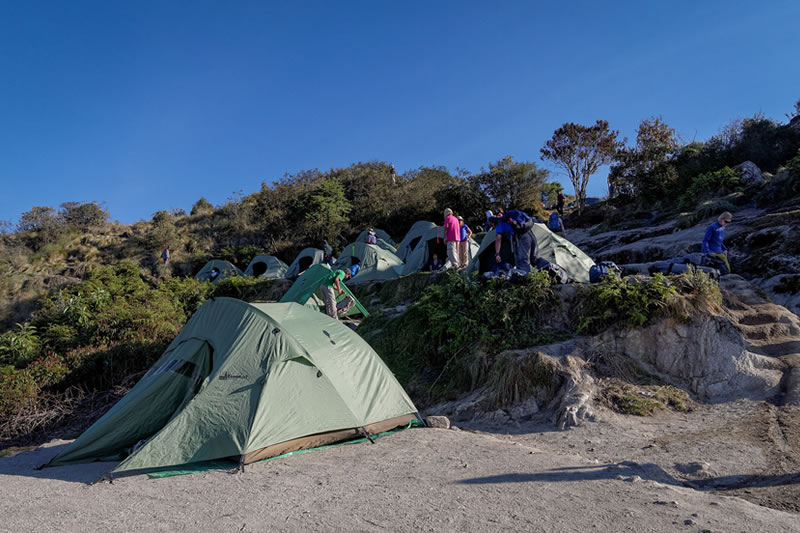
The Inca Trail to Machu Picchu lasts 4 days and 3 nights. Because the route is protected by the Peruvian Ministry of Culture, everything is regulated within the route. There are three established camps where you spend the night: Huayllabamba, Pacaymayo and Wiñayhuayna (or Puyupatamarca). What are these camps like? Including? Learn all about the camps included in this formidable hiking trail.
The nights of camping are already designated by the authorities of the Ministry of Culture of Peru. It is one of the funniest moments of the route as it helps tourists get to know each other better. The team of porters and cooks will have the tents and food ready for each night. Visitors are advised not to drink alcoholic beverages or toxic substances that can harm their health during the difficult walk.
How are the camps during the Inca Trail?
- During the journey to the Inca Trail there are properly marked camping areas. Travel agencies cannot set up their campsites in unmarked places.
- In the camps you can find basic hygiene services. In the last camp (Wiñayhuayna or Phuyupatamarca) you can find basic showers.
- In the camps there is no electricity system or internet network or cell phone signal. It is recommended to take the necessary precautions. Bring a flashlight, get spare batteries or portable chargers.
- The camps are ideal to disconnect from the world and appreciate the multiple stars drawn in the sky.
The Huayllabamba camp
- Huayllabamba comes from a Quechua word that means ‘grassy plain’.
- It is located 2,750 meters above sea level.
- Dinner and the first night of the Inca Trail take place there. Dinner is held in a well-equipped tent. The camps are spacious tents (for one or two people).
- When, after 6 hours of walking, the tourist arrives at the camp, everything (the tents, dining rooms, etc.) will already be installed.
The Pacaymayo camp
- Pacaymayo is one of the tributary rivers of the famous Vilcanota, the sacred river of the Incas that runs through Machu Picchu.
- Pacaymayo is also the second camp during the Inca Trail tour. It is located approximately 3,500 meters above sea level.
- You arrive at this camp after 6 to 7 hours of walking (the most challenging day as you cross the Warmiwañusca pass, the highest point at 4,200 meters above sea level.)
- The camp has hygienic services, spacious areas to accommodate the tents and garbage cans. Similarly, by the time the tourist arrives in Pacaymayo, all the implements will be ready to use.
The Wiñayhuayna or Puyupatamarca camp
- Wiñayhuayna is one of the Inca archaeological sites that can be appreciated during the 4-day Inca Trail. Its name comes from a Quechua word that means ‘Eternally young’ (in reference to one of the many species of orchids that abound there).
- Wiñayhuayna is also the name of the third and last camp during the route to Machu Picchu. When the available spaces are exceeded, the Ministry of Culture of Peru assigns the Puyupatamarca camp.
- Puyupatamarca is also the name of one of the archaeological sites located on the Inca Trail route. As well as Wiñayhuayna, the Puyupatamarca camp has wide spaces, garbage cans, bathrooms, showers and more.
- You arrive at this camp after an approximate 8 hours of walking. When the tourist arrives, the porters (people who carry the equipment) will have all the utensils for the camp ready.
- On this last night of camping, tourists usually tip the porters, cooks, and tour guide who accompanied them on the Inca Trail. Then the porters and cooks say goodbye.

Camps raised
More information
- The camps are assigned by the authorities of the Ministry of Culture of Peru through coordination with tourism agencies. Tourists request the tour with these agencies.
- In addition to the night camps of Huayllabamba, Pacaymayo and Wiñayhuayna (or Puyupatamarca); there are others for lunch. The food and the camps will already be ready for when the tourist arrives.
- Camp areas are permanently protected by guards. You will be safe. The surveillance staff will be in charge of controlling any risk that may arise.
- Remember in the camps that there should be no trace of your step. Trash bags are available. All waste must be turned over to agency staff. The support staff will be in charge of selecting organic and inorganic solid waste and removing it from the Inca Trail.
- Remember that the camps do not include personal items such as sleeping bags. Know how to organize the travel backpack during the Inca Trail.
- If you find any debris, collect it and give it to the staff of the tourism agency or tour guide that accompanies you. The Inca Trail is a route with a lot of history and that must be protected by visitors.
By Inca Trail Machu Picchu - Last updated, 22-08-2024
Interested in the Inca Trail? Know more about Information Inca Trail!
- Inca Trail hike as a therapy to heal body and soul
- What is it like to camp overnight on the Inca Trail?
- Online availability Inca Trail to Machu Picchu 2025
- Sustainability tips for the Inca Trail
- How to get to Ollantaytambo?
- Physical preparation for the Inca Trail
